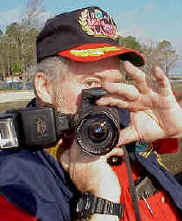Lakecaster Online Archives – Feb, 2002
Lake Sam Rayburn, TX.
It was check-out-time at the “crappie motels” as our boats hovered over several deep-water brush-patches dropping “wedgies” down to try and hook a few of the guests, and with some of Sam Rayburn’s top-rated crappie anglers fishing onboard, it was just a matter of time before these motels would have to re-hang their “vacancy” signs.
Sam Rayburn has long been known as a premier fishing lake with the black bass getting most of the headlines from the outdoor press. But Rayburn has kept a secret within itself these past many years, which is slowly coming to light as being one of the finest crappie fisheries in our nation today.
“You really need to come along with us in the morning, Bob Sealy had invited to me the previous day, explaining that a special fishing group was going out to test a new line of soft plastic crappie baits that Stanley Jigs was developing for the sport-fishing market. Among the impressive list of anglers who were to be launching in the morning was Bob Sealy, of Sealy Outdoors, Lonnie Stanley, of Stanley Baits, Tejas fishing guides Charlie Trahan & Bill Fondren, and “ME” as I was NOT to miss this golden fishing opportunity.
“Lets go, “We’re burning daylight, Charlie Trahan gruffed as we tarried about waiting for the early morning fog to lift. We would be fishing in post cold-front conditions with high-pressure blue-bird skies and rising lake waters after previous days of changing weather “dumped” several inches of rain on the lake area.
After a “chilly” but invigorating boat-run to an Ayish Bayou area creek-flat, Bill and Charlie, who have over 50 years of Rayburn fishing experiences between them, throttled down their boats to sonar-search a timber flat for some under-water brush-patches that they hoped would be holding some “Rayburn-Gold” for us to catch.
“There they are, Bill alerted to Charlie as he quickly tossed out two red fishing buoys to mark what he had spotted on his depth recorder. “Immediately, Charlie circled his boat over the marked area and tossed out his own red buoys, not far from where Bill’s were situated. “We work together as a team, Bill informed, “as I just marked the inside shallow water edges of the brush, with Charlie coming in to mark the deep water outside edges. “That way, Bill further explained, “we can concentrate our fishing efforts within that buoyed area to help keep our baits where the crappie are holding. After Bill moved forward to man his troll-motor, a quick peek at his depth recorder screen suddenly had me digging for my camera to take a photo of the screen that showed a large group of fish concentrated around some brush-piles that were situated some 35-feet below us.
“The larger slab crappie should still be down there, Bill advised as he handed me a rod rigged with a 32 nd oz jig-head threaded with a plastic grass-shrimp colored “wedgie” that had a small split-shot attached about 10 inches above it. “We had fished this area right before the storms hit, Bill noted, “catching 60 crappie, with some over 2 lbs and losing one that probably would have topped the present 2.94 lb lake record. “Gee, what happened, I asked? “Got the dang thing into the boat, Bill grumbled, “when it flipped free of the line and flopped right back into the water before I could get my hands on it!
“Fish on”, yelped Bob Sealy as he hooked and landed the first crappie of the morning, a solid slab of about 1 & 1 / 2 lbs. “It hit right on the bottom, Sealy advised, after live-welling his catch before re-casting for another. It was 9:am and our day had just begun.
“Cast to the buoy markers and let your bait sweep-down to the bottom, Bill instructed, “then just bounce it along back to the boat. “If you snag-up, he explained, just jiggle your rod tip a little and the counter reaction of the split-shot weight should free the jig from the brush-snag. It’s not long before Bill’s advice is tested as my first cast results in a snag, but quickly jiggles free after heeding the instructions. But before I could wind a retrieve, a slight “thump” bowed my rod, which resulted in my first crappie, a nice pounder.
“We were probably catching between 75 to 100 crappie a day before that front blew through with its 6 inch rains, Charlie informed, “I can vouch for that, Sealy spoke up after landing another large crappie, “we must’ve caught well over 100 crappie in just two hours that day, Bob grinned, “explaining that they only kept about 30 of the larger slabs, with some of them weighing well over two pounds.
“At this time of year with the lake waters cooling, Bill advised, “the crappie will bunch up around these deepwater brush-piles along the flats and points of the creek and river channels. “Then, along about February when the waters begin to warm up some, the crappie will start migrating back to the shallower structure as they begin staging within the hydrilla beds before moving up the creeks to spawn in the brush about mid March.
“We are 100% artificial bait anglers, Charlie advised, “and we are also field testers for Stanley Baits. “We definitely do that, Bill chimed in, “as we find that we can catch a lot more crappie with artificial baits, and with much better results on the larger sized slab crappie. “And these new soft plastics from Stanley are really incredible for doing just that, Bob Sealy praised, “I’ve never seen such action that these little baits provide for attracting the feeding instinct of cold water crappie. “And figure this, Bob alerted, “with these baits providing such catches in the chill of winter from mostly inactive fish, can you just imagine what they will do when fished in the warmer, more active waters of spring?
“Wedge-Tailed Mighty Minnows is what we’re calling them, Lonnie Stanley informed my notes, “and it’s all in the unique action that the tail provides. “I was once called “the minnow guy of Zavala”, chuckled Lonnie, “explaining that he usually went crappie fishing with at least 8 to 10 dozen live minnows on-board his boat “until” he went fishing with Bill & Charlie one day where they out-fished his minnow dipping techniques by three to one with their jigging methods, “that day, Lonnie informed, “quickly changed my crappie fishing attitude “and” started me on a business venture to develop a new line of soft plastic baits that would “innovate” and “revolutionize” the fishing industry.
“Which is why we’re now developing this new patented “wedge-tailed” minnow that provides some excellent action from a tail design that continuously “vibrates” through the water, which really turns on the crappie and can actually activate them into a feeding spree when several of these baits are being fished in the same fishing area. “You can really feel the difference, Lonnie explained, “when you cast it out and allow it to flutter down and see the tail work as it drops, then on the retrieve you can feel the drag of the tail as it pushes water and vibrates its way through your fishing area. “Kind of like what a spinner-bait does when slow-rolled, Lonnie stated with a knowing grin.
“In real cold water, Bill pointed out, “the crappie normally become dormant and un-feeding with most anglers fishing live minnows to attract their bites. “And often then not, the crappie will just suck-up the minnows, barely mouthing the bait, which makes it hard to feel them when they bite. “But these new Stanley plastic baits create a tremendous amount of vibration when retrieved through the water, which can actually incite them into a more aggressive feeding strike that makes them much easier to feel and catch.
“Our whole Wedge-Tail line, from the saltwater shrimps and eight inch minnows, all the way down to the new wacky style worms, to the inch and a half wedge-tailed minnows, Lonnie informed, “was introduced to us in April of last year and everyone has been excited about working on them to get them lined up for this years fishing season. “We have eleven different molds and 144 colors in 10 differently styled baits, Lonnie advised, “which will be shipped to Bass Pro Shops, Oshman’s, Academy Sports, and K-Mart stores “nation-wide” in time for the early winter and spring fishing season.
“We, at Stanley Baits, Lonnie finalized, “are really excited about these new baits as in the 21 year history of our company we have never seen a designed plastic bait like these that can catch such a large variety of fish, which include redfish, trout, flounder, saltwater & freshwater stripers, as well as bass, crappie, and even bream or perch. “But what is going to make this new bait so appealing to the fishing public, Lonnie advised, “is that it is just as effective when fished in saltwater bays, freshwater lakes, rivers, creeks, ponds, or in any fishing area that the public chooses to fish in. “Even tournament anglers have high confidence levels when fishing with them, as do the Dad’s or Mom’s who fish with their kids in farm ponds. “And it really doesn’t matter if you’re fishing muddy or clear water conditions because of the “vibration” that these Wedge-Tailed baits can produce that attracts the feeding interests of just about any fish that you enjoy fishing for.
“You can flip it like a fluke, crank it a like a crank-bait, slow-roll it like a spinner-bait, hump it like a jig, or even Carolina or Texas rig it, Stanley advised, “as I feel that this new bait will revolutionize fishing in much the same way that all the other now “famous” artificial baits have done in the past.
My day of crappie fishing with this group has caused me to reconfigure my crappie tackle box drastically as I now have “retired” most of the plastic tube-baits, twister tails, grubs, and hair-jigs that I had accumulated over my many years of crappie fishing, replacing them with the new “Wedge-Tails” that Lonnie kindly “loaned” me for this fishing trip, as well as for many others in the future. These new plastics are incredible folks, and much like Lonnie Stanley has predicted, I feel that they will definitely revolutionize the soft plastics market that now dominates the freshwater and saltwater sport fishing markets.
For more information on the new Stanley Baits “Wedge-Tails” contact Stanley Baits at (936)-876-5713, and if you desire to experience some OJT with these new baits with some on-site crappie fishing seminars, you can contact the Stanley Baits field testing team of Bill Fondren and Charlie Trahan at (409)-698-3491.
Copyright © 1999 – 2005 by Lakecaster Publications, Onalaska, Tx. All rights reserved. Usage rights granted to Toledo-Bend.Com





 Rayburn Gold
Rayburn Gold